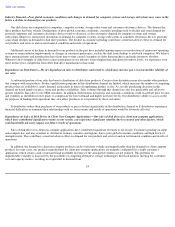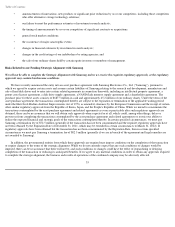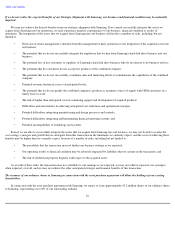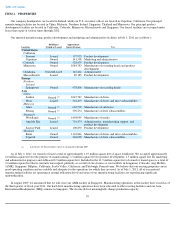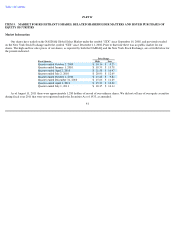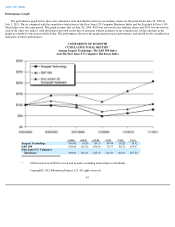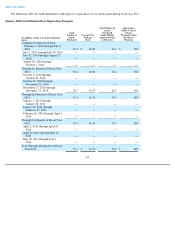Seagate 2010 Annual Report Download - page 37
Download and view the complete annual report
Please find page 37 of the 2010 Seagate annual report below. You can navigate through the pages in the report by either clicking on the pages listed below, or by using the keyword search tool below to find specific information within the annual report.
Table of Contents
Environmental Regulations
—Failure to comply with applicable environmental laws and regulations could have a material adverse effect on
our business, results of operations and financial condition.
The sale and manufacturing of products in certain states and countries may subject us to environmental and other regulations including, in
some instances, the responsibility for environmentally safe disposal or recycling. For example, the EU has enacted the Restriction of the Use of
Certain Hazardous Substances in Electrical and Electronic Equipment directive, which prohibits the use of certain substances in electronic
equipment, and the Waste Electrical and Electronic Equipment directive, which obligates parties that place electrical and electronic equipment
onto the market in the EU to put a clearly identifiable mark on the equipment, register with and report to EU member countries regarding
distribution of the equipment, and provide a mechanism to take-back and properly dispose of the equipment. Similar legislation may be enacted
in other locations where we manufacture or sell our products. Although we do not anticipate any material adverse effects based on the nature of
our operations and the focus of such legislation, we will need to ensure that we comply with these laws and regulations as they are enacted and
that our suppliers also comply with these laws and regulations. If we fail to timely comply with the legislation, our customers may refuse to
purchase our products, which would have a material adverse effect on our business, results of operations and financial condition. In addition, if
we were found to be in violation of these laws or noncompliance with these initiatives or standards of conduct, we could be subject to
governmental fines, liability to our customers and damage to our reputation, which would also have a material adverse effect on our business,
results of operations and financial condition.
Seasonality
—Because we experience seasonality in the sales of our products, our results of operations will generally be adversely impacted
during the second half of our fiscal year.
Sales of computer systems, storage subsystems and consumer electronics tend to be seasonal, and therefore we expect to continue to
experience seasonality in our business as we respond to variations in our customers' demand for disk drives. In particular, we anticipate that sales
of our products will continue to be lower during the second half of our fiscal year. In the client compute and client non-compute market
applications of our business, this seasonality is partially attributable to the historical trend in our results derived from our customers' increased
sales of desktop computers, notebook computers, and consumer electronics during the back-to-school and winter holiday season. In the
enterprise market our sales are seasonal because of the capital budgeting and purchasing cycles of our end users. Since our working capital needs
peak during periods in which we are increasing production in anticipation of orders that have not yet been received, our results of operations will
fluctuate seasonally even if the forecasted demand for our products proves accurate. Furthermore, it is difficult for us to evaluate the degree to
which this seasonality may affect our business in future periods because of the rate and unpredictability of product transitions and new product
introductions, particularly in the client non-compute market, as well as macroeconomic conditions.
Volatile Public Markets—The price of our ordinary shares may be volatile and could decline significantly.
The stock market, in general, and the market for technology stocks in particular, has recently experienced volatility that has often been
unrelated to the operating performance of companies. If these market or industry-based fluctuations continue, the trading price of our ordinary
shares could decline significantly independent of our actual operating performance, and you could lose all or a substantial part of your
investment. The market price of our ordinary shares could fluctuate significantly in response to several factors, including among others:
•
general uncertainty in stock market conditions occasioned by global economic conditions, negative financial news and the
continued instability of several large financial institutions;
•
actual or anticipated variations in our results of operations;
34


